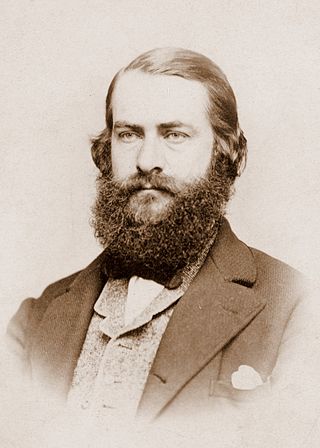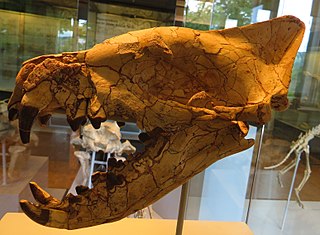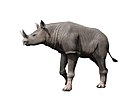
Equidae is the taxonomic family of horses and related animals, including the extant horses, asses, and zebras, and many other species known only from fossils. The family evolved around 50 million years ago from a small, multi-toed ungulate into larger, single-toed animals. All extant species are in the genus Equus, which originated in North America. Equidae belongs to the order Perissodactyla, which includes the extant tapirs and rhinoceros, and several extinct families. It is more specifically grouped within the superfamily Equoidea, the only other family being the extinct Palaeotheriidae.

Joseph Mellick Leidy was an American paleontologist, parasitologist and anatomist.

Merychippus is an extinct proto-horse of the family Equidae that was endemic to North America during the Miocene, 15.97–5.33 million years ago. It had three toes on each foot and is the first horse known to have grazed.

Hyaenodon ("hyena-tooth") is an extinct genus of carnivorous placental mammals from extinct tribe Hyaenodontini within extinct subfamily Hyaenodontinae, that lived in Eurasia and North America from the middle Eocene, throughout the Oligocene, to the early Miocene.

The evolution of the horse, a mammal of the family Equidae, occurred over a geologic time scale of 50 million years, transforming the small, dog-sized, forest-dwelling Eohippus into the modern horse. Paleozoologists have been able to piece together a more complete outline of the evolutionary lineage of the modern horse than of any other animal. Much of this evolution took place in North America, where horses originated but became extinct about 10,000 years ago, before being reintroduced in the 15th century.

Pseudhipparion is an extinct genus of three-toed horse endemic to North America during the Miocene. They were herding animals whose diet consisted of C3 plants. Fossils found in Georgia and Florida indicate that it was a lightweight horse, weighing up to 90 pounds. In 2005, fossils were unearthed in Oklahoma. Seven species of Pseudhipparion are known from the fossil record which were very small, following the trend of Bergmann's rule.

Nannippus is an extinct genus of three-toed horse endemic to North America during the Miocene through Pleistocene, about 13.3—1.8 million years ago (Mya), living around 11.5 million years. This ancient species of three-toed horse grew up to 3.5 feet and weighed between 165 pounds to 199 pounds, which was around the same size as a domestic sheep.

Cormohipparion is an extinct genus of horse belonging to the tribe Hipparionini that lived in North America during the late Miocene to Pliocene. They grew up to 3 feet long.

Nimravides is a genus of extinct saber-toothed cats that lived in North America during the Late Miocene, between 10.3 and 5.332 Ma. Despite its scientific name, Nimravides does not belong to the Nimravidae, but is a true cat belonging to the family Felidae.

Equini is the only living tribe of the subfamily Equinae, which has lived worldwide since the Hemingfordian stage of the Middle Miocene. It is considered to be a monophyletic clade.
The Alachua Formation is a Miocene geologic formation in Florida. The claystones, sandstones and phosphorites of the formation preserve many fossils of mammals, birds, reptiles and fish, among others megalodon.

The Ash Hollow Formation of the Ogallala Group is a geological formation found in Nebraska and South Dakota. It preserves fossils dating back to the Neogene period. It was named after Ash Hollow, Nebraska and can be seen in Ash Hollow State Historical Park. Ashfall Fossil Beds State Historical Park is within this formation.

The Valentine Formation is a geologic unit formation or member within the Ogallala unit in northcentral Nebraska near the South Dakota border. It preserves fossils dating to the Miocene epoch of the Neogene period and is particularly noted for Canid fossils. This unit consists of loosely-consolidated sandstone that crumbles easily. These sands carry the water of the Ogallala Aquifer and is the source of much of the water in the Niobrara River. A particular feature of the Valentine is lenticular beds of green-gray opaline sandstone that can be identified in other states, including South Dakota, Nebraska, Kansas, and Colorado. Although three mammalian fauna stages can be mapped throughout the range of the Ogallala, no beddings of the Ogallala are mappable and all attempts of formally applying the Valentine name to any mappable lithology beyond the type location have been abandoned. Even so, opaline sandstone has been used to refer to this green-gray opalized conglomerate sandstone that is widely found in the lower Ogallala Formation.
The Gracias Formation is a geologic formation in Honduras. The mainly sandstones, siltstones and claystones preserve vertebrate fossils dating back to the Neogene period.
Hyperailurictis is an extinct genus of felid from Miocene North America. The Hyperailurictis species are Pseudaelurus-grade felids and thought to be the first felids in the Americas.

Agorophius is an extinct genus of toothed whale that lived during the Oligocene period, approximately 32 million years ago, in the waters off what is now South Carolina.

Calippus is an extinct genus of hoofed mammals in the horse family (Equidae), known from the Middle Miocene through the Early Pliocene of North and Central America. Fossils have been found in the Central United States and the Eastern United States, ranging south to Honduras. These equines had high crowned teeth and a quadrangular, wide muzzle, and were small compared to their contemporary relatives, with C. elachistus weighing 49 kg, C. cerasinus weighing 102 kg, 132 kg for C. theristes and 73 kg for C. mccartyi.
Ischyrotherium is an extinct genus named by Joseph Leidy in 1856 for fossils from the lignite deposits in Nebraska. Originally considered an herbivorous cetacean, Leidy then reassigned it to Sirenia as a relative of manatees, before Edward Drinker Cope reclassified it as a non-mammalian, suggesting the new name Ischyrosaurus to better identify its reptilian origins, as he considered it a sauropterygian. Ischyrotherium was found alongside material from the hadrosaur Thespesius and turtles Compsemys and Emys, and the fish Mylognathus. The name Ischyrosaurus was also used by John Whitaker Hulke for the sauropod now known as Ornithopsis manseli, as he was unaware it was preoccupied by Cope.

Hyaenodontoidea is a superfamily of extinct predatory mammals from extinct order Hyaenodonta. Fossil remains of these mammals are known from early Eocene to early Miocene deposits in North America, Europe and Asia.

Hyaenodontinae is an extinct subfamily of predatory placental mammals from extinct family Hyaenodontidae. Fossil remains of these mammals are known from early Eocene to early Miocene deposits in Europe, Asia and North America.




























